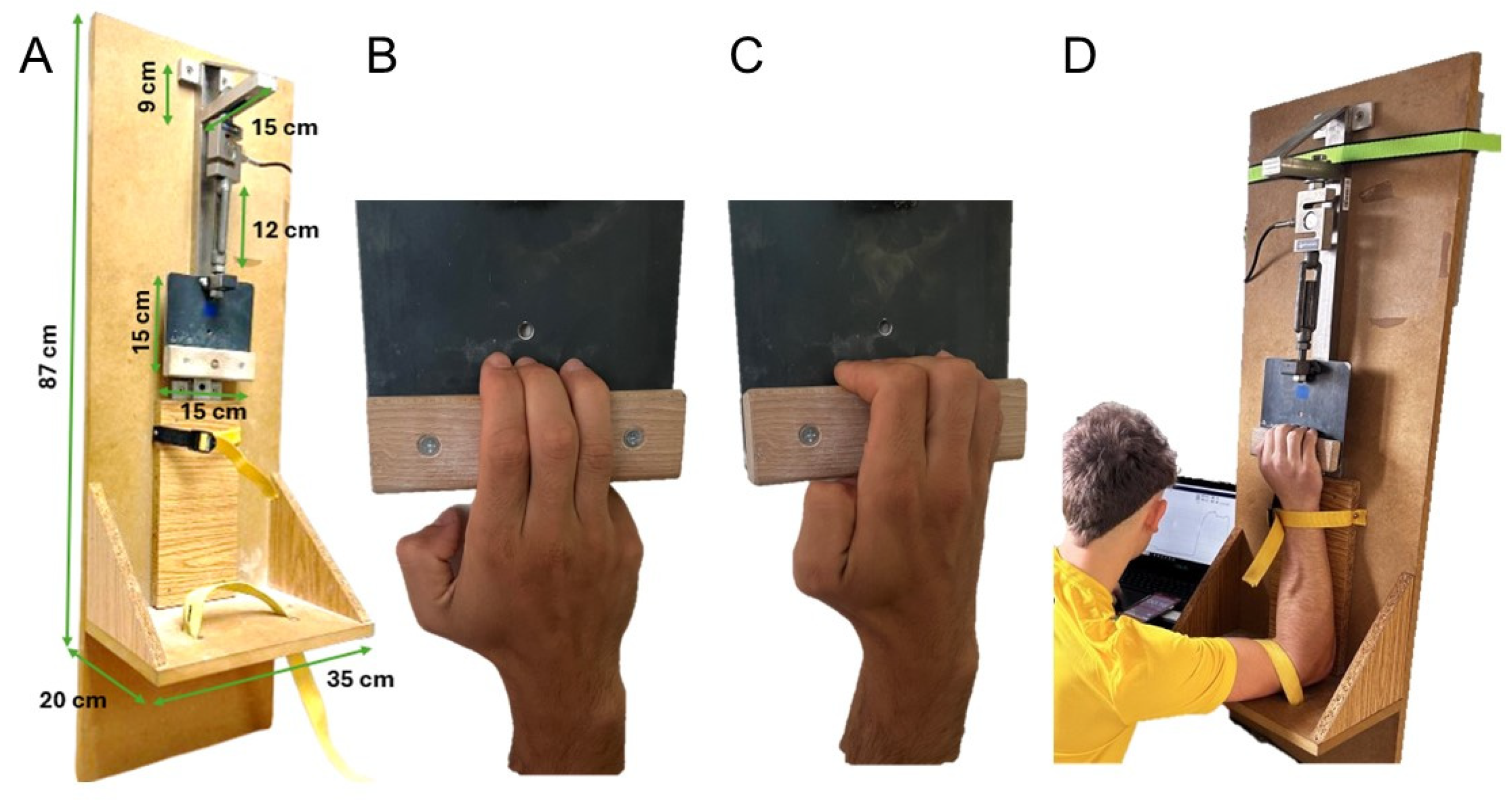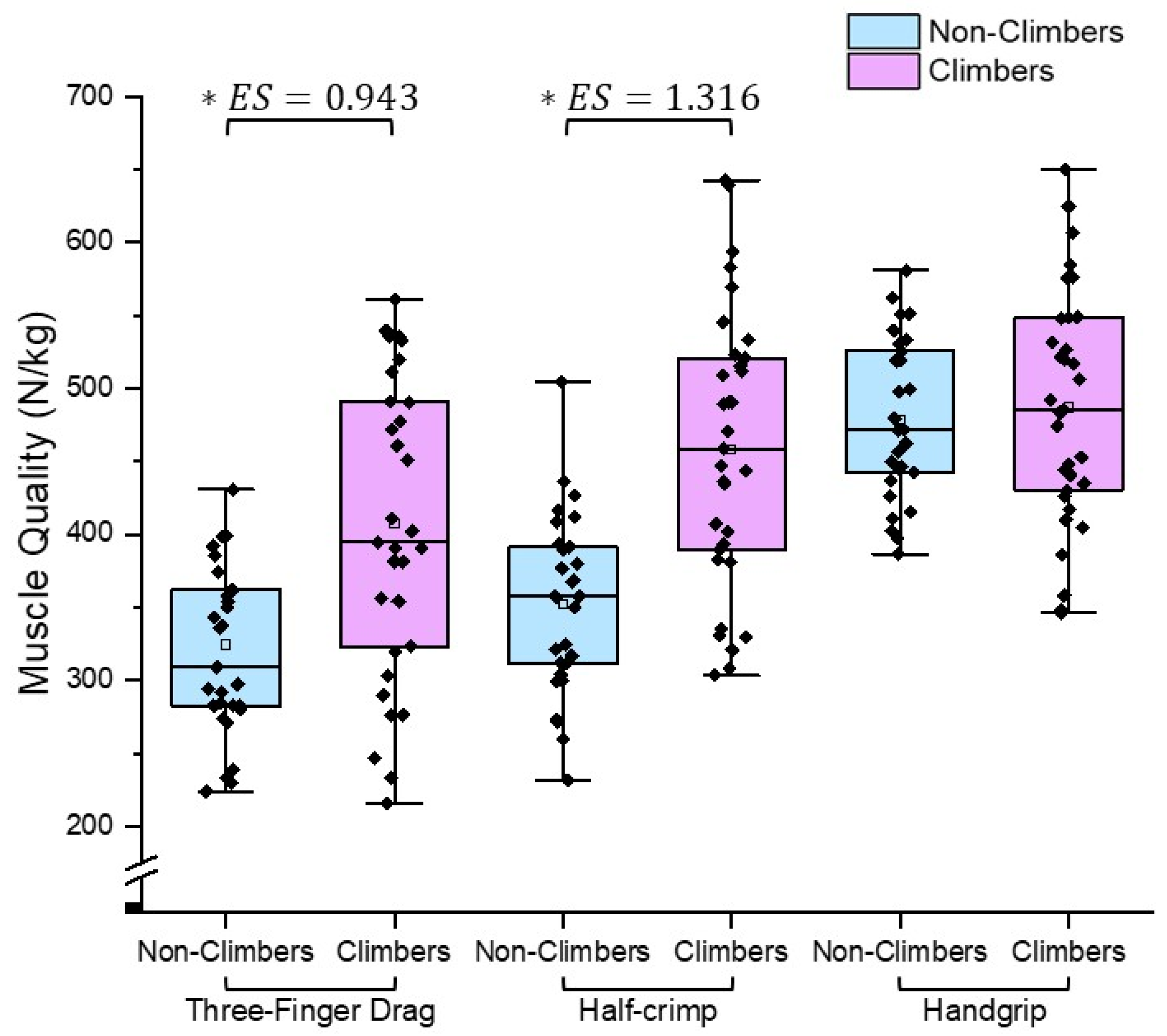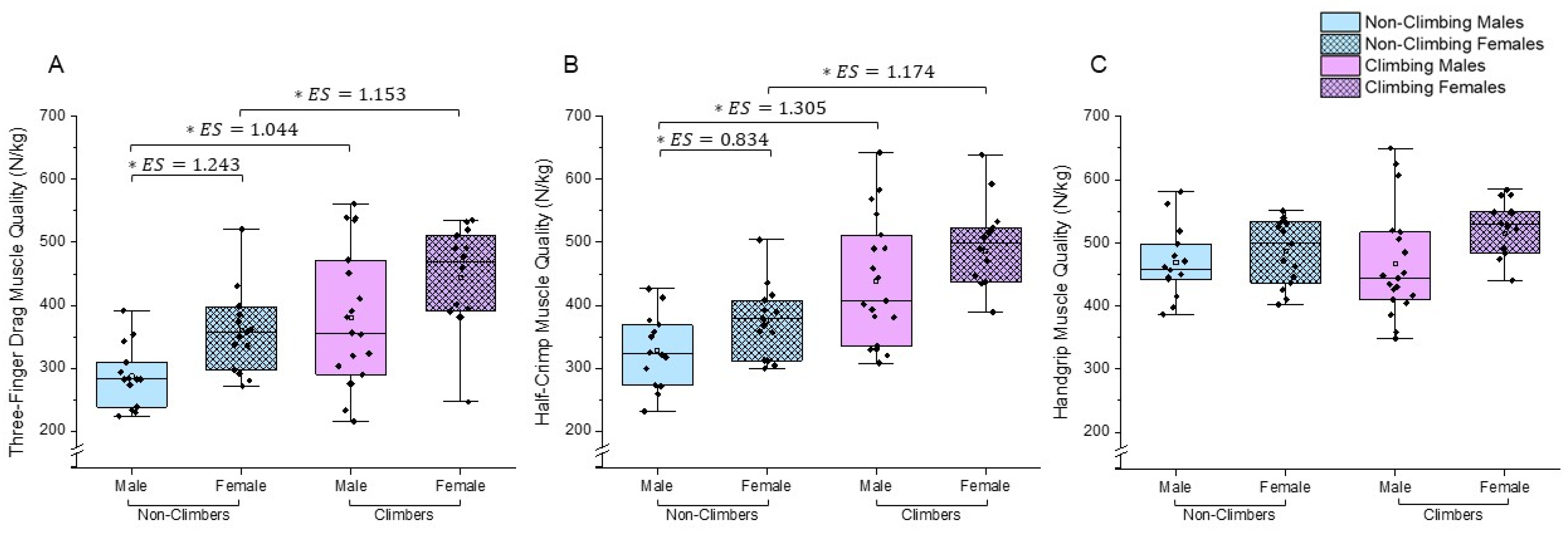Comparison of Finger Flexor Strength and Muscle Quality Between Climbers and Non-Climbers: Influence of Sex and Grip Type
Abstract
1. Introduction
2. Materials and Methods
2.1. Subjects
2.2. Muscle Strength Assessment
2.3. Body Composition and Muscle Quality Assessment
2.4. Statistical Analysis
3. Results
3.1. Participant Characteristics
3.2. Isometric Strength
Relative Strength to Body Weight
3.3. Muscle Quality
3.4. Reliability
4. Discussion
4.1. Climbing-Specific Strength vs. General Dynamometry
4.2. Body Composition and Muscle Quality Differences
4.3. Reliability of Climbing-Specific Tests
4.4. Practical Implications and Limitations
5. Conclusions
Author Contributions
Funding
Institutional Review Board Statement
Informed Consent Statement
Data Availability Statement
Acknowledgments
Conflicts of Interest
Abbreviations
| MQ | Muscle Quality |
| DXA | Dual-energy X-ray Absorptiometry |
| ROI | Region of Interest |
| ISCD | International Society for Clinical Densitometry |
| IRCRA | International Rock Climbing Research Association |
| ICC | Intraclass Correlation Coefficient |
| SEM | Standard Error of Measurement |
| MCD95 | Minimum Detectable Change at 95% Confidence |
| CV | Coefficient of Variation |
| SD | Standard Deviation |
| RPE | Rate of Perceived Exertion |
| MVC | Maximum Voluntary Isometric Contraction |
References
- Saul, D.; Steinmetz, G.; Lehmann, W.; Schilling, A.F. Determinants for success in climbing: A systematic review. J. Exerc. Sci. Fit. 2019, 17, 91–100. [Google Scholar] [CrossRef] [PubMed]
- Assmann, M.; Steinmetz, G.; Schilling, A.F.; Saul, D. Comparison of Grip Strength in Recreational Climbers and Non-Climbing Athletes-A Cross-Sectional Study. Int. J. Environ. Res. Public Health 2020, 18, 129. [Google Scholar] [CrossRef] [PubMed]
- Grant, S.; Hasler, T.; Davies, C.; Aitchison, T.C.; Wilson, J.; Whittaker, A. A comparison of the anthropometric, strength, endurance and flexibility characteristics of female elite and recreational climbers and non-climbers. J. Sports Sci. 2001, 19, 499–505. [Google Scholar] [CrossRef] [PubMed]
- Laffaye, G.; Levernier, G.; Collin, J.M. Determinant factors in climbing ability: Influence of strength, anthropometry, and neuromuscular fatigue. Scand. J. Med. Sci. Sports 2016, 26, 1151–1159. [Google Scholar] [CrossRef]
- Levernier, G.; Laffaye, G. Rate of force development and maximal force: Reliability and difference between non-climbers, skilled and international climbers. Sports Biomech. 2021, 20, 495–506. [Google Scholar] [CrossRef]
- Limonta, E.; Cè, E.; Gobbo, M.; Veicsteinas, A.; Orizio, C.; Esposito, F. Motor unit activation strategy during a sustained isometric contraction of finger flexor muscles in elite climbers. J. Sports Sci. 2016, 34, 133–142. [Google Scholar] [CrossRef]
- MacLeod, D.; Sutherland, D.L.; Buntin, L.; Whitaker, A.; Aitchison, T.; Watt, I.; Bradley, J.; Grant, S. Physiological determinants of climbing-specific finger endurance and sport rock climbing performance. J. Sports Sci. 2007, 25, 1433–1443. [Google Scholar] [CrossRef]
- Giles, D.; Barnes, K.; Taylor, N.; Chidley, C.; Chidley, J.; Mitchell, J.; Torr, O.; Gibson-Smith, E.; España-Romero, V. Anthropometry and performance characteristics of recreational advanced to elite female rock climbers. J. Sports Sci. 2021, 39, 48–56. [Google Scholar] [CrossRef]
- Baláš, J.; Pecha, O.; Martin, A.J.; Cochrane, D.J. Hand–arm strength and endurance as predictors of climbing performance. Eur. J. Sport Sci. 2012, 12, 16–25. [Google Scholar] [CrossRef]
- Ozimek, M.; Staszkiewicz, R.; Rokowski, R.; Stanula, A. Analysis of Tests Evaluating Sport Climbers’ Strength and Isometric Endurance. J. Hum. Kinet. 2016, 53, 249–260. [Google Scholar] [CrossRef]
- van Bergen, N.G.; Soekarjo, K.; Van der Kamp, J.; Orth, D. Reliability and Validity of Functional Grip Strength Measures Across Holds and Body Positions in Climbers: Associations With Skill and Climbing Performance. Res. Q. Exerc. Sport 2023, 94, 627–637. [Google Scholar] [CrossRef] [PubMed]
- Stien, N.; Saeterbakken, A.H.; Andersen, V. Tests and Procedures for Measuring Endurance, Strength, and Power in Climbing-A Mini-Review. Front. Sports Act. Living 2022, 4, 847447. [Google Scholar] [CrossRef] [PubMed]
- Stien, N.; Andersen, V.; Langer, K.; Saeterbakken, A.H. Assessing climbing-specific strength: The impact of body position and elbow flexion on reliability and predictive validity. J. Sports Sci. 2025, 43, 852–864. [Google Scholar] [CrossRef]
- Söderqvist, K.; Identeg, F.; Zimmerman, J.; Senorski, E.H.; Sansone, M.; Hedelin, H. Validity and Reliability of Finger-Strength Testing in 6 Common Grip Techniques for the Assessment of Bouldering Ability in Men. Int. J. Sports Physiol. Perform. 2024, 19, 290–298. [Google Scholar] [CrossRef]
- Amca, A.M.; Vigouroux, L.; Aritan, S.; Berton, E. Effect of hold depth and grip technique on maximal finger forces in rock climbing. J. Sports Sci. 2012, 30, 669–677. [Google Scholar] [CrossRef]
- Nelson-Wong, E.; Lorbiecki, C.; Wood, S.; Huang, S.; Crawley, J.; Higgins, E.; Parker, L.; Cowell, K. Influence of Experience, Training Frequency, and Sex on Climbing-Specific Grip Force in Rock Climbers of Varying Skill Level. J. Appl. Biomech. 2025, 41, 142–150. [Google Scholar] [CrossRef]
- Vigouroux, L.; Quaine, F.; Labarre-Vila, A.; Moutet, F. Estimation of finger muscle tendon tensions and pulley forces during specific sport-climbing grip techniques. J. Biomech. 2006, 39, 2583–2592. [Google Scholar] [CrossRef]
- Schweizer, A.; Hudek, R. Kinetics of crimp and slope grip in rock climbing. J. Appl. Biomech. 2011, 27, 116–121. [Google Scholar] [CrossRef]
- Michailov, M.L.; Baláš, J.; Tanev, S.K.; Andonov, H.S.; Kodejška, J.; Brown, L. Reliability and Validity of Finger Strength and Endurance Measurements in Rock Climbing. Res. Q. Exerc. Sport 2018, 89, 246–254. [Google Scholar] [CrossRef]
- Fanchini, M.; Violette, F.; Impellizzeri, F.M.; Maffiuletti, N.A. Differences in climbing-specific strength between boulder and lead rock climbers. J. Strength Cond. Res. 2013, 27, 310–314. [Google Scholar] [CrossRef]
- Rokowski, R.; Michailov, M.; Maciejczyk, M.; Więcek, M.; Szymura, J.; Draga, P.; Trendafilov, P.; Szygula, Z. Muscle strength and endurance in high-level rock climbers. Sports Biomech. 2024, 23, 1057–1072. [Google Scholar] [CrossRef] [PubMed]
- Langer, K.; Simon, C.; Wiemeyer, J. Physical performance testing in climbing-A systematic review. Front. Sports Act. Living 2023, 5, 1130812. [Google Scholar] [CrossRef]
- Barbat-Artigas, S.; Rolland, Y.; Zamboni, M.; Aubertin-Leheudre, M. How to assess functional status: A new muscle quality index. J. Nutr. Health Aging 2012, 16, 67–77. [Google Scholar] [CrossRef] [PubMed]
- McGregor, R.A.; Cameron-Smith, D.; Poppitt, S.D. It is not just muscle mass: A review of muscle quality, composition and metabolism during ageing as determinants of muscle function and mobility in later life. Longev. Heal. 2014, 3, 9. [Google Scholar] [CrossRef]
- Naimo, M.A.; Varanoske, A.N.; Hughes, J.M.; Pasiakos, S.M. Skeletal Muscle Quality: A Biomarker for Assessing Physical Performance Capabilities in Young Populations. Front. Physiol. 2021, 12, 706699. [Google Scholar] [CrossRef]
- MacKenzie, R.; Monaghan, L.; Masson, R.A.; Werner, A.K.; Caprez, T.S.; Johnston, L.; Kemi, O.J. Physical and Physiological Determinants of Rock Climbing. Int. J. Sports Physiol. Perform. 2020, 15, 168–179. [Google Scholar] [CrossRef]
- Augste, C.; Winkler, M.; Künzell, S. Optimization of an Intermittent Finger Endurance Test for Climbers Regarding Gender and Deviation in Force and Pulling Time. Front. Sports Act. Living 2022, 4, 902521. [Google Scholar] [CrossRef]
- Smetanka, R.G.; Armenta, R.F.; Nessler, J.A.; Newcomer, S.C. Heart Rate Response, Duration, Grip Strength, and Anthropometric Characteristics in Recreational Indoor Rock Climbers. J. Strength Cond. Res. 2022, 36, 832–837. [Google Scholar] [CrossRef]
- España-Romero, V.; Ortega Porcel, F.B.; Artero, E.G.; Jiménez-Pavón, D.; Gutiérrez Sainz, A.; Castillo Garzón, M.J.; Ruiz, J.R. Climbing time to exhaustion is a determinant of climbing performance in high-level sport climbers. Eur. J. Appl. Physiol. 2009, 107, 517–525. [Google Scholar] [CrossRef]
- Lopes, L.C.C.; Vaz-Gonçalves, L.; Schincaglia, R.M.; Gonzalez, M.C.; Prado, C.M.; de Oliveira, E.P.; Mota, J.F. Sex and population-specific cutoff values of muscle quality index: Results from NHANES 2011–2014. Clin. Nutr. 2022, 41, 1328–1334. [Google Scholar] [CrossRef]
- Mehra, A.; Snarr, R.L.; Park, K.S.; Krok-Schoen, J.L.; Czerwinski, S.A.; Nickerson, B.S. Muscle quality index comparisons between Hispanics and non-Hispanic Caucasians using dual energy X-ray absorptiometry and handgrip strength. Eur. J. Clin. Nutr. 2024, 78, 1064–1071. [Google Scholar] [CrossRef] [PubMed]
- Draper, N.; Giles, D.; Schöffl, V.; Konstantin Fuss, F.; Watts, P.; Wolf, P.; Baláš, J.; Espana-Romero, V.; Blunt Gonzalez, G.; Fryer, S. Comparative grading scales, statistical analyses, climber descriptors and ability grouping: International Rock Climbing Research Association position statement. Sports Technol. 2015, 8, 88–94. [Google Scholar] [CrossRef]
- Quaine, F.; Vigouroux, L.; Paclet, F.; Colloud, F. The thumb during the crimp grip. Int. J. Sports Med. 2011, 32, 49–53. [Google Scholar] [CrossRef] [PubMed]
- Baláš, J.; Panáčková, M.; Kodejška, J.; Cochrane, J.D.; Martin, J.A. The role of arm position during finger flexor strength measurement in sport climbers. Int. J. Perform. Anal. Sport 2014, 14, 345–354. [Google Scholar] [CrossRef]
- Philippe, M.; Wegst, D.; Müller, T.; Raschner, C.; Burtscher, M. Climbing-specific finger flexor performance and forearm muscle oxygenation in elite male and female sport climbers. Eur. J. Appl. Physiol. 2012, 112, 2839–2847. [Google Scholar] [CrossRef]
- Garcia, K.; Jaramillo, D.; Rubesova, E. Ultrasound evaluation of stress injuries and physiological adaptations in the fingers of adolescent competitive rock climbers. Pediatr. Radiol. 2018, 48, 366–373. [Google Scholar] [CrossRef]
- Ferrer-Uris, B.; Arias, D.; Torrado, P.; Marina, M.; Busquets, A. Exploring forearm muscle coordination and training applications of various grip positions during maximal isometric finger dead-hangs in rock climbers. PeerJ 2023, 11, e15464. [Google Scholar] [CrossRef]
- Macdonald, J.H.; Callender, N. Athletic profile of highly accomplished boulderers. Wilderness Environ. Med. 2011, 22, 140–143. [Google Scholar] [CrossRef]
- Marcolin, G.; Faggian, S.; Muschietti, M.; Matteraglia, L.; Paoli, A. Determinants of Climbing Performance: When Finger Flexor Strength and Endurance Count. J. Strength Cond. Res. 2022, 36, 1099–1104. [Google Scholar] [CrossRef]
- Ginszt, M.; Saito, M.; Zięba, E.; Majcher, P.; Kikuchi, N. Body Composition, Anthropometric Parameters, and Strength-Endurance Characteristics of Sport Climbers: A Systematic Review. J. Strength Cond. Res. 2023, 37, 1339–1348. [Google Scholar] [CrossRef]
- Okoren, L.; Magkos, F. Physiological Characteristics, Dietary Intake, and Supplement Use in Sport Climbing. Curr. Nutr. Rep. 2023, 12, 788–796. [Google Scholar] [CrossRef] [PubMed]
- Carrasco, F.; Arias-Tellez, M.J.; Solar-Altamirano, I.; Inostroza, J.; Carrasco, G. Regional Body Composition and Strength, Not Total Body Composition, Are Determinants of Performance in Climbers. J. Funct. Morphol. Kinesiol. 2024, 9, 228. [Google Scholar] [CrossRef] [PubMed]
- Watts, P.B. Physiology of difficult rock climbing. Eur. J. Appl. Physiol. 2004, 91, 361–372. [Google Scholar] [CrossRef] [PubMed]
- Giles, L.V.; Rhodes, E.C.; Taunton, J.E. The physiology of rock climbing. Sports Med. 2006, 36, 529–545. [Google Scholar] [CrossRef]
- Mermier, C.M.; Janot, J.M.; Parker, D.L.; Swan, J.G. Physiological and anthropometric determinants of sport climbing performance. Br. J. Sports Med. 2000, 34, 359–365; discussion 366. [Google Scholar] [CrossRef]
- Haizlip, K.M.; Harrison, B.C.; Leinwand, L.A. Sex-based differences in skeletal muscle kinetics and fiber-type composition. Physiology 2015, 30, 30–39. [Google Scholar] [CrossRef]
- Hawley, S.E.; Bell, Z.W.; Huang, Y.; Gibbs, J.C.; Churchward-Venne, T.A. Evaluation of sex-based differences in resistance exercise training-induced changes in muscle mass, strength, and physical performance in healthy older (≥60 y) adults: A systematic review and meta-analysis. Ageing Res. Rev. 2023, 91, 102023. [Google Scholar] [CrossRef]



| Outcome | All Participants | Male | Female | Sex Differences | ||||||||||
|---|---|---|---|---|---|---|---|---|---|---|---|---|---|---|
| Non-Climbers (n = 29) | Climbers (n = 33) | ES | p | Non-Climbers (n = 14) | Climbers (n = 19) | ES | p | Non-Climbers (n = 15) | Climbers (n = 14) | ES | p | p Non-Climb. | p Climb. | |
| Age (years) | 23.2 ± 3.1 | 27.6 ± 3.5 | 1.303 | 0.001 | 23.2 ± 3.4 | 27.2 ± 3.8 | 1.105 | 0.004 | 23.2 ± 3.1 | 28.1 ± 3.2 | 1.560 | 0.001 | 0.991 | 0.497 |
| Weight (kg) | 67.4 ± 11.1 | 64.3 ± 11.1 | 0.279 | 0.278 | 75.0 ± 6.9 | 69.7 ± 10.8 | 0.555 | 0.125 | 60.3 ± 9.6 | 56.8 ± 6.1 | 0.427 | 0.261 | 0.001 | 0.001 |
| Height (cm) | 168.8 ± 9.9 | 171.7 ± 8.0 | 0.319 | 0.215 | 175.0 ± 7.7 | 176.2 ± 6.3 | 0.185 | 0.602 | 163.1 ± 8.2 | 165.4 ± 5.7 | 0.335 | 0.375 | 0.001 | 0.001 |
| BMI (kg/m2) | 23.5 ± 2.5 | 21.7 ± 3.0 | 0.646 | 0.014 | 24.5 ± 1.9 | 22.5 ± 3.4 | 0.701 | 0.056 | 22.6 ± 2.7 | 20.7 ± 1.8 | 0.802 | 0.040 | 0.037 | 0.099 |
| LMI (%) | 17.4 ± 2.8 | 17.0 ± 2.8 | 0.126 | 0.622 | 19.9 ± 1.8 | 18.7 ± 2.1 | 0.607 | 0.095 | 15.1 ± 0.9 | 14.8 ± 1.8 | 0.185 | 0.623 | 0.001 | 0.001 |
| FMI (%) | 5.0 ± 2.3 | 3.7 ± 2.0 | 0.626 | 0.017 | 3.6 ± 1.3 | 2.9 ± 2.0 | 0.391 | 0.276 | 6.4 ± 2.1 | 4.9 ± 1.4 | 0.884 | 0.025 | 0.001 | 0.003 |
| Body Fat (%) | 21.5 ± 8.9 | 17.0 ± 8.0 | 0.532 | 0.041 | 14.5 ± 4.9 | 12.3 ± 5.6 | 0.419 | 0.243 | 28.1 ± 6.3 | 23.5 ± 6.0 | 0.739 | 0.057 | 0.001 | 0.001 |
| Forearm Muscle (g) | 844 ± 269 | 930 ± 249 | 0.310 | 0.228 | 1076 ± 179 | 1120 ± 223 | 0.213 | 0.549 | 628 ±105 | 673 ± 83 | 0.472 | 0.215 | 0.001 | 0.001 |
| Arm Span (cm) | 170.7 ± 12.2 | 171.7 ± 9.0 | 0.097 | 0.706 | 178.7 ± 8.4 | 176.4 ± 8.2 | 0.281 | 0.432 | 163.3 ± 10.5 | 165.5 ± 5.5 | 0.258 | 0.493 | 0.001 | 0.001 |
| Ape Index | 1.011 ± 0.03 | 1.001 ± 0.03 | 0.380 | 0.141 | 1.022 ± 0.03 | 1.001 ± 0.03 | 0.729 | 0.047 | 1.001 ± 0.02 | 1.001 ± 0.03 | 0.008 | 0.983 | 0.034 | 0.999 |
| Forearm Length (cm) | 27.2 ± 2.4 | 27.2 ± 1.7 | 0.008 | 0.976 | 28.6 ± 2.0 | 28.2 ± 1.3 | 0.268 | 0.452 | 25.9 ±1.9 | 25.8 ± 1.1 | 0.029 | 0.939 | 0.001 | 0.001 |
| Outcome | All Participants | Male | Female | Sex Dif. | ||||||||||
|---|---|---|---|---|---|---|---|---|---|---|---|---|---|---|
| Non-Climbers (n = 29) | Climbers (n = 33) | ES | p | Non-Climbers (n = 14) | Climbers (n = 19) | ES | p | Non-Climbers (n = 15) | Climbers (n = 14) | ES | p | p Non-Climb. | p Climb. | |
| Three-finger drag (N) | 260.3 ± 63.9 | 358.1 ± 109.9 | 1.070 | 0.001 | 301.3 ± 43.9 | 407.6 ± 114.7 | 1.158 | 0.003 | 222.2 ± 56.0 | 290.9 ± 55.4 | 1.234 | 0.003 | 0.001 | 0.001 |
| Half-crimp (N) | 285.0 ± 74.9 | 409.2 ± 121.3 | 1.214 | 0.001 | 341.6 ± 52.6 | 476.6 ± 113.5 | 1.452 | 0.001 | 232.1 ± 49.3 | 317.6 ± 52.0 | 1.689 | 0.001 | 0.001 | 0.001 |
| Handgrip (N) | 398.8 ± 120.8 | 442.6 ± 119.6 | 0.365 | 0.157 | 501.7 ± 85.5 | 515.8 ± 103.2 | 0.147 | 0.680 | 302.8 ± 43.9 | 343.4 ± 45.2 | 0.911 | 0.021 | 0.001 | 0.001 |
| Three-finger drag/BW (N/kg) | 3.9 ± 0.6 | 5.6 ± 1.4 | 1.567 | 0.001 | 4.0 ± 0.6 | 5.9 ± 1.6 | 1.440 | 0.001 | 3.7 ± 0.6 | 5.1 ± 0.9 | 1.911 | 0.001 | 0.127 | 0.127 |
| Half-crimp/BW (N/kg) | 4.2 ± 0.8 | 6.3 ± 1.4 | 1.822 | 0.001 | 4.6 ± 0.8 | 6.9 ± 1.5 | 1.801 | 0.001 | 3.9 ± 0.6 | 5.6 ± 0.8 | 2.355 | 0.001 | 0.010 | 0.009 |
| Handgrip/BW (N/kg) | 5.9 ± 1.2 | 6.9 ± 1.4 | 0.796 | 0.003 | 6.7 ± 0.9 | 7.4 ± 1.4 | 0.626 | 0.085 | 5.1 ± 0.7 | 6.1 ± 0.9 | 1.219 | 0.003 | 0.001 | 0.003 |
| Outcome | Mean | SD | ICC (95% CI) | CV (%) | SEM | SEM (%) | MCD | MCD (%) | |
|---|---|---|---|---|---|---|---|---|---|
| Three-finger drag (N) | 295.25 | ± | 15.2 | 0.969 (0.953–0.981) | 5.35 | 17.52 | 5.93 | 48.55 | 16.42 |
| Half-crimp (N) | 333.10 | ± | 19.1 | 0.962 (0.942–0.976) | 5.81 | 22.65 | 6.79 | 62.79 | 18.82 |
| Handgrip (N) | 406.24 | ± | 22.3 | 0.936 (0.895–0.961) | 5.67 | 30.23 | 7.44 | 83.79 | 20.63 |
Disclaimer/Publisher’s Note: The statements, opinions and data contained in all publications are solely those of the individual author(s) and contributor(s) and not of MDPI and/or the editor(s). MDPI and/or the editor(s) disclaim responsibility for any injury to people or property resulting from any ideas, methods, instructions or products referred to in the content. |
© 2025 by the authors. Licensee MDPI, Basel, Switzerland. This article is an open access article distributed under the terms and conditions of the Creative Commons Attribution (CC BY) license (https://creativecommons.org/licenses/by/4.0/).
Share and Cite
González-Martín, D.; Santos-Pérez, J.; Maroto-Izquierdo, S.; de Paz, J.A.; Gallego-Selles, Á. Comparison of Finger Flexor Strength and Muscle Quality Between Climbers and Non-Climbers: Influence of Sex and Grip Type. Appl. Sci. 2025, 15, 7161. https://doi.org/10.3390/app15137161
González-Martín D, Santos-Pérez J, Maroto-Izquierdo S, de Paz JA, Gallego-Selles Á. Comparison of Finger Flexor Strength and Muscle Quality Between Climbers and Non-Climbers: Influence of Sex and Grip Type. Applied Sciences. 2025; 15(13):7161. https://doi.org/10.3390/app15137161
Chicago/Turabian StyleGonzález-Martín, Diego, Javier Santos-Pérez, Sergio Maroto-Izquierdo, José Antonio de Paz, and Ángel Gallego-Selles. 2025. "Comparison of Finger Flexor Strength and Muscle Quality Between Climbers and Non-Climbers: Influence of Sex and Grip Type" Applied Sciences 15, no. 13: 7161. https://doi.org/10.3390/app15137161
APA StyleGonzález-Martín, D., Santos-Pérez, J., Maroto-Izquierdo, S., de Paz, J. A., & Gallego-Selles, Á. (2025). Comparison of Finger Flexor Strength and Muscle Quality Between Climbers and Non-Climbers: Influence of Sex and Grip Type. Applied Sciences, 15(13), 7161. https://doi.org/10.3390/app15137161










